In my last blog post I discussed focusing your training on the first five shots of a rally, as this is where most points are won and lost. In my view, this is the quickest way to improve your win percentage.
In this blog post I share 10 training drill ideas for the first five shots of a rally. Below are two drills each for service, receive, 3rd ball, 4th ball and 5th ball. Each drill includes a diagram, step-by-step instructions and suggestions for making the drill harder.
This isn’t a complete list – there are loads of different drills you can do. But if you don’t currently practice the first five shots, these drills are a good place to start. For other drill ideas, speak to a coach or advanced player at you club.
There’s also a useful chapter on a 5 ball training system in the book Table Tennis: Steps to Success, which includes lots of training drill ideas for the first 5 shots. A useful book to buy.
And please do share any training drills you use in the comments box below.
Service training drill 1: 10 in a row
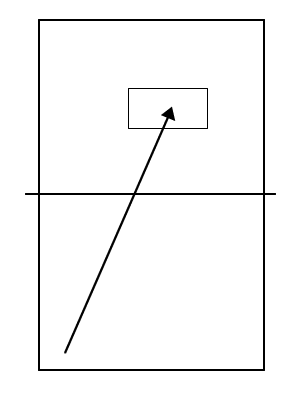
This is a good drill to improve your service accuracy under pressure. The aim is to hit a target 10 times in a row without error. As you get closer to 10, you’ll probably find that you start to get a little tense. This replicates what may happen in a match when the score is close at the end of a set. You can use this drill for any of your serves – backspin, sidespin, topspin, no spin, and any length – short, half-long, long.
- Place a target (e.g. piece of paper) on your opponent’s half of the table.
- Choose one serve and aim for the second bounce to hit the target.
- Keep serving until you hit the target 10 times in a row. If you miss the target start again from 0.
To make it harder:
- Make the target smaller, e.g. fold the piece of paper in half.
Service training drill 2: Target practice
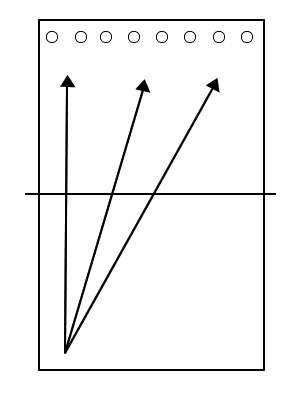
This is quite a fun service practice drill. The aim is to knock multiple targets off the table in as few serves as possible. It’s a good way to practice serving to all areas on the table. You can turn it into a competition with other players. The player who knocks all the targets off the table the quickest is the winner.
- Place 8 targets (e.g. plastic cups) in different positions on your opponent’s half of the table.
- Keep serving until you have knocked all targets off the table.
To make it harder:
- Make the target smaller, e.g. use broken balls instead of plastic cups.
Receive drill 1: Flick or topspin
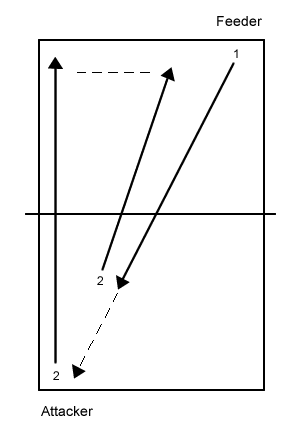
In this drill you will practice attacking your opponent’s serve. The aim is to attack with lots of speed and spin to try and win the point on the 2nd ball or force a weak return.
- 1st ball: The feeder serves either short or long backspin to the attacker’s backhand.
- 2nd ball: If the serve is short, the attacker plays a backhand flick to any position on the table. If the serve is long, the attacker plays a backhand topspin to any position on the table. If the ball is returned, play out the point.
To make it harder:
- The feeder puts more backspin on the serve.
To make it irregular:
- The feeder serves to any position on the backhand side of the table.
Receive drill 2: Backhand or elbow
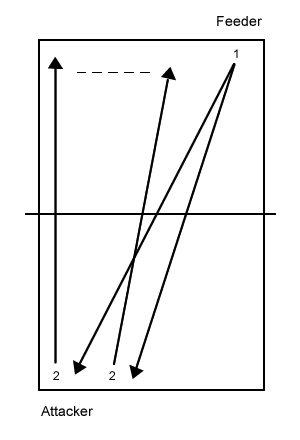
In this drill you will practice returning long side-spin serves. The aim again is to attack with lots of speed to try and win the point on the 2nd ball. You also get to practice footwork for those tricky serves to the elbow.
- 1st ball: The feeder serves long sidespin to either the attacker’s backhand or elbow.
- 2nd ball: If the serve is to the backhand, the attacker plays a backhand topspin to any position on the table. If the serve is to the elbow, the attacker plays a forehand topspin to any position on the table. If the ball is returned, play out the point.
To make it harder:
- The feeder varies the speed and spin of the serve
3rd ball drill 1: Sidespin serve, forehand topspin
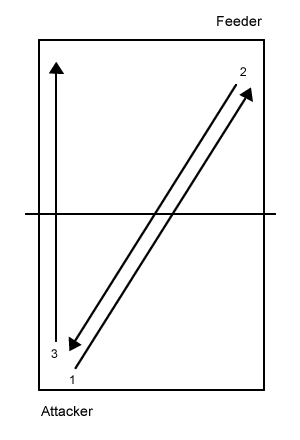
A common 3rd ball attack routine. You move your opponent out wide with a sidespin serve and then play a fast topspin in the opposite corner. The key is to use the full width of the table to really stretch your opponent.
- 1st ball: The attacker serves sidespin wide to the feeder’s backhand.
- 2nd ball: The feeder plays a medium speed backhand topspin to the attacker’s backhand side.
- 3rd ball: The attacker steps around and plays a fast forehand topspin to the feeder’s forehand corner to try and win the point. If the ball is returned, play out the point.
To make it harder:
- The feeder increases the speed of the backhand topspin (2nd ball)
To make it irregular:
- The feeder returns the serve with either a push or topspin (2nd ball)
- The feeder returns the serve to any position on the attacker’s backhand side (2nd ball)
3rd ball drill 2: Backspin serve, backhand topspin
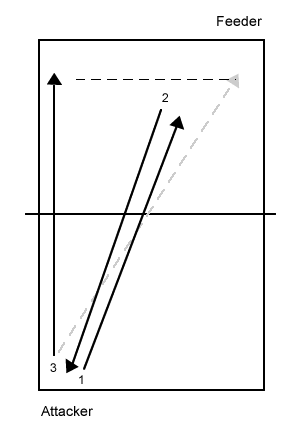
Another common 3rd ball attack routine. You serve half-long backspin to your opponent’s elbow, really trying to hit their their crossover point to force a weak return. You then topspin to anywhere on the table to try and win the point on the 3rd ball.
- 1st ball: The attacker serves half-long backspin to the feeder’s elbow.
- 2nd ball. The feeder pushes to the attacker’s backhand corner.
- 3rd ball: The attack plays a backhand topspin to any position on the table to try and win the point. If the ball is returned, play out the point.
To make it harder:
- The feeder puts more backspin on the push (2nd ball)
To make it irregular:
- The feeder pushes short or long (2nd ball)
- The feeder pushes to any position on the attacker’s backhand side (2nd ball)
4th ball drill 1: Backhand flick and backhand topspin
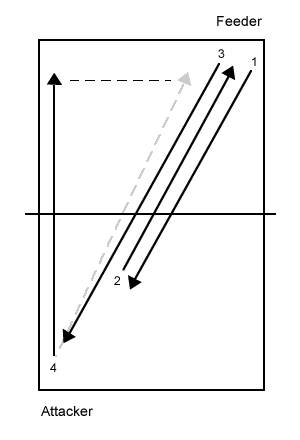
In this drill you will practice flicking a short backspin serve and then playing a backhand topspin against a block return. The idea is to put your opponent under pressure with an attacking return of serve and then finish off the point with 4th ball. It’s also a useful drill to practice forwards and backwards footwork, as you have to step in to play the flick and then step out to topspin the blocked return.
- 1st ball: The feeder serves short backspin to the attacker’s backhand.
- 2nd ball: The attacker plays a backhand flick to the feeder’s backhand.
- 3rd ball: The feeder blocks the ball to the attacker’s backhand.
- 4th ball: the attacker plays a backhand topspin to any position on the table to try and win the point. If the ball is returned, play out the point.
To make it harder:
- The feeder puts more backspin on the serve (1st ball)
- The feeder increases the speed of the block (3rd ball)
To make it irregular:
- The feeder serves to backhand or middle (1st ball).
- The feeder blocks to backhand or forehand corner (3rd ball). If blocked to the forehand corner, the attacker should play a forehand topspin.
4th ball drill 2: Fast push and fast topspin
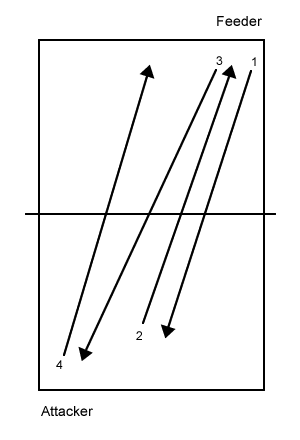
In this drill you will practice playing an aggressive push to try and force a weak attack from your opponent and then following up with a fast topspin for the 4th ball. Many players struggle to attack heavy backspin pushes, so it’s a very useful tactic to use. This is also a useful drill to practice switching between a push stroke and a topspin stroke.
- 1st ball: The feeder serves half-long backspin to the attacker’s elbow.
- 2nd ball: The attacker plays a fast, long backhand push to the attacker’s backhand.
- 3rd ball: The feeder plays a medium speed backhand topspin to the attacker’s backhand.
- 4th ball: The attacker steps around and plays a fast forehand topspin to the feeder’s elbow to try and win the point. If the ball is returned, play out the point.
To make it harder:
- The feeder increases the speed of the backhand topspin (3rd ball)
To make it irregular:
- The feeder serves backspin, no spin or sidespin (1st ball)
- The feeder topspins to anywhere on the table (3rd ball)
5th ball drill 1: Two forehand topspins
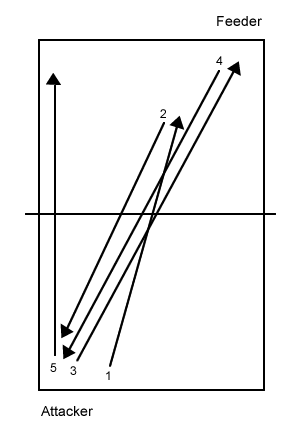
In this drill you will practice switching between attacking a backspin return and then attacking a topspin return, both with your forehand. This is a very common combination in table tennis and requires an important change of bat angle between the two topspins. You also get to practice playing attacking topspins crosscourt and down the line.
- 1st ball: The attacker serves half-long backspin to the feeder’s elbow.
- 2nd ball: The feeder pushes long to the attacker’s backhand corner.
- 3rd ball: The attacker steps around and plays a slow, heavy forehand topspin to the feeder’s backhand.
- 4th ball: The feeder blocks back to the attacker’s backhand corner.
- 5th ball: The attacker plays a fast forehand topspin down the line to try and win the point. If the ball is returned, play out the point.
To make it harder
- The feeder puts more backspin on the push (2nd ball)
- The feeder varies the pace of the block – some faster, some slower (4th ball)
To make it irregular
- The feeder pushes to anywhere on attacker’s backhand side (2nd ball)
- The feeder blocks to either backhand or forehand corner (4th ball)
5th ball drill 2: Backhand and forehand topspins
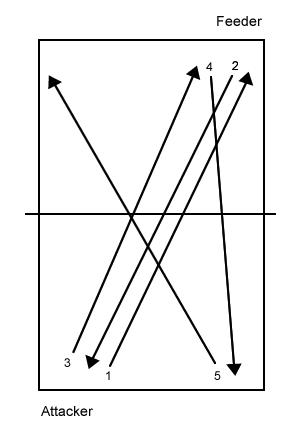
In this drill you will practise attacking a topspin return of serve and switching between backhand and forehand attacks. This is a fast five ball training drill, as the pace is added on the serve and maintained or increased with the return of serve. This is a good drill if you want to improve playing quick topspin rallies.
- 1st ball: The attacker serves long (sidespin or topspin) to the feeder’s backhand.
- 2nd ball: The feeder topspins to the attacker’s backhand.
- 3rd ball: The attacker plays a backhand topspin to the feeder’s backhand.
- 4th ball: The feeder blocks to the attacker’s forehand.
- 5th ball: The attacker plays a forehand topspin crosscourt to try and win the point. If the ball is returned, play out the point.
To make it harder:
- The feeder increases the speed of the topspin return of serve (2nd ball)
- The feeder increases the speed of the block (4th ball)
To make it irregular
- The feeder topspins to anywhere on the backhand side (2nd ball)
- The feeder blocks to forehand or backhand corner (4th ball). If blocked to backhand corner, the attacker can play a forehand or backhand topspin.
More training drills
If you would like more training drill ideas, I recommend you join Tom’s TT Academy. In my online academy, you will get access to my training drill library. Every training drill includes a video demonstration, plus technical tips and ideas to make the drill easier or harder.
When you join my academy, you will also get access to a wide range of coaching content, including:
- in-depth courses
- video analysis
- fitness videos
- robot training videos
- member discussions
- skill challenges
- and lot’s more!
You can access all this content for less than £1 per week. New content is added regularly. Join hundreds of table tennis players around the world today at tomsttacademy.com
